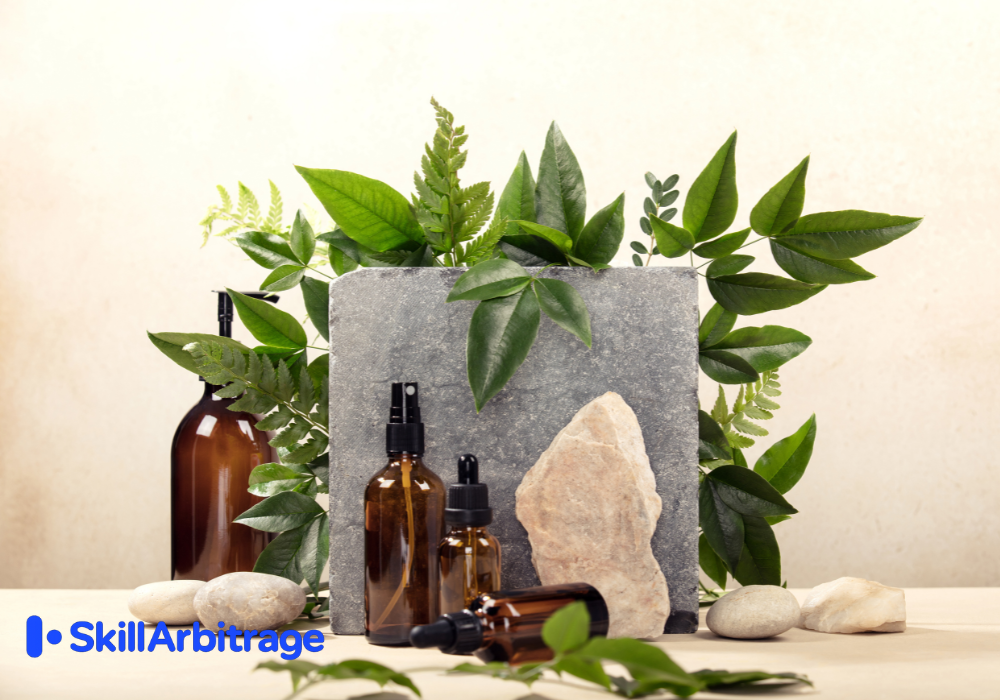This article shows freelancers and marketers how to break free from the commodity trap by turning any product or service into a luxury brand through ritual-based strategies. You’ll learn 5 practical steps to create emotional value that commands high markups and builds lasting customer loyalty.
Table of Contents
Do you remember the TikTok storm in early 2025? When a viral video exposed the secret: those “luxury” handbags cost $57 to make but sold for $5,000? People lost their minds. Scandalous, right?
But here is the twist. Hermès and Chanel did not collapse under the backlash. Nope. They thrived. Why? Because they do not just sell leather or shiny stuff. They sell a ritual. Think Chanel No. 5’s bedtime spritz. More than perfume, it is a nightly promise to yourself. Or Hermès’ Birkin waitlist, which turns buying a bag into a pilgrimage, a story you tell yourself and others.
The raw materials? Cheap. The markup? Insane. Branding does the heavy lifting here, driving prices 10 to 20 times higher. The luxury market is on track to hit $617 billion by 2030, and it is all fueled by these rituals, not the product specs.
If you are a freelancer, marketer, or entrepreneur stuck selling $15 mugs or $20 candles that feel ordinary, this article is your ticket out. You will learn 5 ritual-based moves to pump up your product’s value without changing what you sell, just how people feel about it.
Step 1: Target your audience’s aspirational identity
Here’s a no-nonsense truth before we dive in:
You can’t sell luxury by talking about features. Not really. People don’t buy a product because it’s “durable” or “functional.” They buy because it fits the story they tell themselves about who they want to be.
Luxury isn’t about the leather, the stitching, or even the scent. It’s about the ritual, the experience, the feeling, and the identity wrapped around the product.
So before you start crafting fancy ads or slapping on premium prices, you have to know one thing: who are you selling to really? Not just their age or job title. Their dreams, their ambitions, the version of themselves they’re chasing.
Get that right, and you’re not selling a $15 planner anymore. You’re selling a future CEO’s morning ritual.
Now, let’s break down how to find and target that aspirational identity.
Define who your customers want to become
Forget the usual demographics. Saying a planner is for “busy professionals” is lazy, and it won’t move the needle. Who really buys that $15 planner? People dreaming of corner offices, the kind who picture themselves running things someday. Future CEOs. Not just people filling out to-do lists.
A $40 candle? It’s not for “women.” That’s the wrong lens. It’s for women who demand elegance. Who light it to feel like they’ve stepped into a Parisian apartment at dusk, even if they’re in a cramped Mumbai flat.
Here’s a $50 scarf. Not for “young women.” For trendsetters. Those who want to be the first to spot and wear what’s next. The ones who want others to catch their drift, to recognize the statement without a word.
This isn’t fluff. It’s the difference between blending in with a commodity and standing out as a luxury. What your customer wants to become sells. Not who they are now.
Uncover emotional drivers with research
Alright, here’s the raw deal on digging into what really moves your audience:
Forget boring surveys. Nobody opens those. You want real talk, unfiltered, messy, and loud. Reddit threads where people spill their guts. TikTok comments under #LuxuryLifestyle that reveal what people actually want, not what marketers think they want. X posts filled with brags and humblebrags. Amazon reviews where customers rant or rave.
Look for patterns. What keeps popping up? Status? Creativity? Calm? Power?
Take tech buyers on X, for example. They’re not just buying gadgets. They see themselves as “innovators.” The disruptors. The ones rewriting the rules. If you can create a ritual that taps into that feeling, like unboxing your product as a startup ritual, you’re not selling a device; you’re selling a badge.
But here’s a confession: most brands stop at demographics. They miss this emotional goldmine. Don’t be most brands.
Step 2: Create a signature ritual for your product
Before you jump into building rituals, you have to understand this: nobody buys a product just because it works. They buy what it means. The status, the feeling, the story they tell themselves when they use it. So your first job is clear. Lock down who your customer wants to be, not who they are now. Nail that, and every ritual you create after will hit harder. Miss it, and you are just selling stuff. Cheap stuff.
Turn everyday use into a premium ceremony
Look, most products are just… stuff. But what if you flipped the script? That $20 mug sitting on your desk? It’s not just a mug. It’s “the morning focus ritual.” The one thing that signals you’re about to get serious. Or that $30 cream? Not just cream, “the nightly renewal ceremony.” Sounds fancy, right? But it’s really about making the everyday feel like a moment worth savoring.
Example: Take a $25 tea blend. It’s not just tea. It’s “the first sip ritual” for wellness lovers. The quiet moment before the chaos. That pause that reminds you to breathe. People don’t buy products. They buy a moment. A feeling. A habit they want to own.
Most brands miss this. They throw features at you like confetti, hoping something sticks. Don’t be that brand. Create a ritual people want to repeat. And yes, repeat. That’s how you get loyalty. That’s how you move from cheap to cherished.
Design repeatable, meaningful experiences
Most products get used once. Maybe twice. Then they vanish into the drawer of forgotten things.
But luxury products? They get reused. Repeated. Ritualized.
Not because they’re better. Because they give the buyer something to return to. A feeling. A gesture. A rhythm.
Think about it. You don’t go to Starbucks for the coffee. You go because you get to say, “Triple shot oat milk with vanilla, extra hot.” You feel seen. In control. Like your day is starting your way.
That’s the job: build a small, repeatable moment that becomes part of your buyer’s life.
It could be the morning “dress like a boss” scarf wrap.
The nightly “wind down” candle lighting.
The “5 PM close laptop, open tea” transition.
You’re not just selling a product. You’re installing habits.
And habits beat hype. Every time.
Step 3: Write reverent copy to elevate the ritual
So now you’ve got a ritual. Something small. Personal. Repeatable.
But here’s the thing:
If you don’t talk about it the right way, it just sounds like another habit. Another product. Another feature.
And that kills the magic.
Because rituals don’t sell themselves. Reverence does.
That’s what Step 3 is about.
Craft premium copywriting that inspires devotion
Most people write copy to explain what the product does.
That’s fine if you’re selling vacuum cleaners.
But if you’re building a premium brand? Your words can’t just inform. They have to worship.
Not fake drama. Not empty adjectives. But reverence.
The kind you hear in perfume ads. The kind that makes a $12 lip balm sound like a sacred object.
Example?
Don’t say, “A planner to help you stay organized.”
Say, “A quiet ritual that turns chaos into clarity.”
Don’t say, “A mug to start your morning.”
Say, “The vessel that begins your becoming.”
It might sound over the top. That’s the point.
When people pay 10x more, they don’t want utility.
They want a story they can believe in. One that feels bigger than them.
So, stop writing like a feature list.
Write like you’re blessing an object.
Avoid functional, problem-solving buzzwords
Let’s talk about the words that kill premium.
Not bad design. Not weak pricing. Just… boring words.
“Optimize.”
“Fix.”
“Hack your routine.”
Yawn.
These aren’t luxury words. They belong in SaaS dashboards and self-help podcasts.
Luxury isn’t practical. It’s theatrical. Ceremonial. Sometimes even ridiculous.
Ever seen a Montblanc ad say, “Improves your writing speed”? Of course not. It says, “Make your mark.”
Real-world fix:
Don’t say “protects your earbuds.”
Say “encase your sound in elegance.”
You’re not solving problems. You’re selling identity. Fantasy. A small, sacred pause in someone’s messy day.
Talk like it.
Step 4: Market the ritual with prestige and exclusivity
So now you know that you don’t sell products. You sell identities.
Now, with that nailed down, how do you show it? How do you turn that identity into a ritual people crave?
That’s where the visuals come in.
And yes, visuals matter. They’re the first handshake, the silent promise.
But not just any visuals.
Premium visuals. Rituals you can almost feel through the screen.
That’s what you’re aiming for.
No fluff. No generic shots.
Real moments. Slow. Sensual. Exclusive.
Like a secret club’s invitation, if you get it, you’re in.
Ready? Let’s get there.
Showcase the ritual in premium visuals
Alright, here’s where most people screw up.
They slap on a pretty photo and call it premium.
Nope.
You want prestige? Exclusivity? Then show the ritual like it’s a secret handshake.
Slow-mo candles flickering in dim light.
A pen gliding across crisp paper, not rushed, deliberate.
That $50 watch? Not just a thing on a wrist, it’s the quiet moment before the boss steps into the boardroom and owns it.
Real talk: no one cares about your product until they feel it’s part of something rare, something chosen.
Shoot like a movie. Edit like it’s a tease. Sell like it’s limited.
Because if everyone can get it? It’s not premium. It’s just stuff.
Use scarcity and status to amplify desire
Scarcity? It’s not just a sales trick.
It’s the whole point of luxury.
Look, nobody cares if you say your candle smells like vanilla.
They care if only 100 people can get it.
If you’re telling people, “Hey, come buy this anytime,” you’re competing with Amazon basics.
And losing.
Exclusivity isn’t about being mean or secretive; it’s about making people feel chosen.
Status lives there.
You don’t want customers; you want insiders.
So go ahead, limit the drops, run that waitlist, and number your editions like a collector’s card.
This is how you turn a $20 tea blend into a trophy.
“Exclusive harvest, 200 packs only.” Say that.
Watch how suddenly a simple tea becomes a must-have.
No one’s bragging about their grocery store chai.
But this? This is brag-worthy.
Luxury isn’t about the product.
It’s about the story you sell around it.
And scarcity is your loudest headline.
Step 5: Build a tribe around the ritual
Before you push a product, push a community.
Sounds cheesy? Maybe. But hear me out.
People don’t buy candles or planners. They buy belonging.
Create a community of ritual practitioners
Think about it.
If your $50 planner comes with a Telegram group called “Morning Makers,” suddenly it’s not just paper, it’s a movement.
No one wants to feel like they’re alone in the grind.
They want a squad, a vibe, a tribe that says: “We get you.”
Same with that $40 candle.
Light it, sure. But join the “Evening Reset Collective” on X, where everyone’s trading their wind-down hacks.
That’s how you get people talking. Sharing. Living your brand, not just owning it.
You don’t need millions of followers.
You need the right few who carry your story forward.
A tribe isn’t a side hustle, it’s the whole game.
So build it like you mean it.
Leverage influencers to amplify the ritual
Forget the usual influencer hustle, no fake smiles pushing products they don’t actually use.
Want real juice? Make them live the ritual.
Not just “Hey, check out this thing”, but “Watch me do my morning pour, the way only true coffee lovers get.”
That $25 cup? It’s not just caffeine. It’s the first move in your day’s power play.
Or take a tech creator, show them setting up a $100 gadget, not like a reviewer, but like an innovator, bootstrapping their dream.
It’s storytelling through action, not scripts.
This isn’t influencer marketing. It’s influencer ritual sharing.
That’s how you turn viewers into believers.
Rituals drive luxury value and unstoppable sales
Here’s the truth: rituals aren’t just fluff, they’re the engine behind luxury’s crazy markups and fanatical fans.
Remember the $57 handbag scandal? Everyone freaked out. Still, Chanel and Hermès didn’t skip a beat. Why? Because people don’t buy bags, they buy the stories, the meaning, the secret handshake.
Freelancers? You’re sitting on gold. That $20 mug? It’s not just a mug. It’s the “morning focus ritual.” That $50 planner? Not paper and ink, it’s the “future CEO’s blueprint.”
This isn’t marketing jargon. It’s real muscle.







 Allow notifications
Allow notifications
